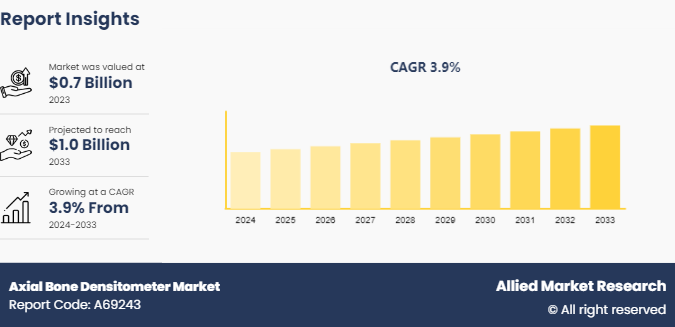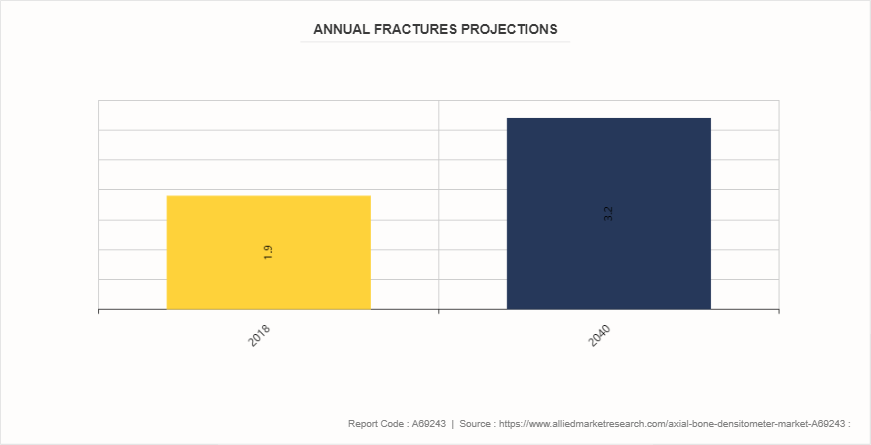Axial Bone Densitometer Market Research, 2033
The global axial bone densitometer market size was valued at $0.7 billion in 2023, and is projected to reach $1.0 billion by 2033, growing at a CAGR of 3.9% from 2024 to 2033.The increasing prevalence of osteoporosis and bone-related disorders is driven by demographic shifts and lifestyle factors

Market Introduction and Definition
An axial bone densitometer is a specialized medical device used to measure bone mineral density (BMD) primarily in the axial skeleton, which includes the spine and hip. It employs dual-energy X-ray absorptiometry (DEXA) technology to assess BMD accurately and diagnose conditions such as osteoporosis. By emitting low-dose X-rays and measuring their absorption, the device provides quantitative data on bone density, aiding in the early detection, monitoring, and management of bone-related disorders. Axial bone densitometers are essential in clinical settings for evaluating fracture risk and assessing the effectiveness of therapeutic interventions aimed at improving bone health and preventing fractures.
Key Takeaways
- The axial bone densitometer market share study covers 20 countries. The research includes a segment analysis of each country in terms of value ($Billion) for the projected axial bone densitometer market forecast period 2024-2033.
- More than 1, 500 product literatures, industry releases, annual reports, and other such documents of major Axial bone densitometer industry participants along with authentic industry journals, trade associations' releases, and government websites have been reviewed for generating high-value industry insights.
- The study integrated high-quality data, professional opinions and analysis, and critical independent perspectives. The research approach is intended to provide a balanced view of global markets and to assist stakeholders in making educated decisions in order to achieve their most ambitious growth objectives.
Key Market Dynamics
Aging populations globally are more susceptible to bone density loss and fractures, contributing to a higher incidence of osteoporosis drives axial bone densitometer market growth. Factors such as sedentary lifestyles, poor nutrition, and hormonal changes further exacerbate bone health issues. This trend underscores the critical need for effective diagnostic tools like Axial Bone Densitometers to assess bone mineral density accurately and manage osteoporosis effectively, ensuring early intervention and reducing the risk of debilitating fractures among older adults.
However, the substantial initial investment and ongoing maintenance costs associated with Axial Bone Densitometers pose a significant barrier to market growth, particularly in resource-limited settings and smaller healthcare facilities. The high-cost limits accessibility to advanced diagnostic tools, impacting adoption rates and widening disparities in bone health management.
Furthermore, technological advancements present a significant opportunity for the Axial Bone Densitometer market. Innovations such as improved imaging resolution, faster scanning times, and enhanced software algorithms for analysis are enhancing the accuracy and efficiency of bone mineral density measurements. Integration with digital health platforms allows for seamless data management and remote monitoring, facilitating better patient care and clinical decision-making. Moreover, advancements in ergonomic designs and patient comfort features are improving user experience and increasing device accessibility across diverse healthcare settings. These advancements not only drive market growth but also enhance diagnostic capabilities and patient outcomes in bone health management.
Annual Fractures projections for Axial bone densitometer Market
According to the data published by MedStar Health Organization, a non-profit health system dedicated in caring for people in Washington D.C region. The projected increase in annual fractures and associated costs due to population aging highlights a burgeoning market for Axial Bone Densitometers. These devices play a crucial role in diagnosing osteoporosis and assessing bone health, essential for early intervention and fracture prevention strategies. With an anticipated 1.9 million to 3.2 million (68% increase) rise in fractures from 2018 to 2040, there is a growing demand for precise and efficient diagnostic tools like Axial Bone Densitometers. This trend not only underscores the importance of advanced healthcare technologies but also presents significant opportunities for market expansion in meeting the escalating healthcare needs related to bone health and fracture management.

Market Segmentation
The axial bone densitometer market is segmented into technology, application and region. On the basis of technology, the market is categorized into dual-energy x-ray absorptiometry, and quantitative computed tomography. On the basis of application, the market is segmented into osteoporosis diagnosis, fracture risk assessment, and others. On the basis of end user, the market is segmented into hospitals, clinics, diagnostic centers, and research institutions. Region wise, it is analyzed across North America, Europe, Asia-Pacific, and LAMEA.
Regional/Country Market Outlook
The Axial Bone Densitometer market share shows varied regional outlooks influenced by healthcare infrastructure, aging populations, and disease prevalence. North America and Europe lead with robust adoption due to advanced healthcare systems and high osteoporosis prevalence among aging demographics. Asia-Pacific exhibits significant growth potential driven by increasing healthcare expenditure and rising awareness of bone health. Latin America and the Middle East also present emerging opportunities with improving healthcare access and expanding diagnostic capabilities. Each region's market dynamics are shaped by local demographics, economic conditions, and regulatory landscapes, influencing the adoption and penetration of Axial Bone Densitometer technologies for osteoporosis diagnosis and management.
- According to an report published by Arthritis Society Canada, in 2021, stated that about 15% of Canadians age 20+ have osteoarthritis and further, More than 4 million Canadians, or about 1 in every 7 adults, have osteoarthritis.
- According to (WHO) World Health Organization estimate, in 2050, 80% of older people will be living in low- and middle-income countries. As the population ages the demand for bone diagnostics increases.
Industry Trends
- In September 2023, an article published by the National Center for Biotechnology and Information (NCBI) stated that more than 1.5 million fractures each year occur due to osteoporosis in America. Approximately 50% of women and 25% of men aged 50 years and above are at risk of experiencing a fracture linked to osteoporosis.
Competitive Landscape
The major players operating in the Axial bone densitometer market size include GE Healthcare, Hologic Inc., Beammed Ltd., DMS Imaging, Swissray International, Inc., MEDILINK, Osteometer MediTech, CompuMed, Inc, Echolight S.p.a, Eurotec Medical Systems srl. Other players in the Axial bone densitometer market include Xingaoyi Medical Equipment Co. Ltd., Trivitron Healthcare, Scanflex Healthcare AB, Medonica Co. LTD, OsteoSys Corp, and so on.
Recent Key Strategies and Developments?
- In June 2021, The Riverside Clinic in London, under the Healthshare Group, expanded its services from diagnostics to surgeries. When considering a new service to aid GP referrals for osteoporosis diagnosis and to support consultants with body fat composition assessments, The Riverside Clinic evaluated available DXA solutions, including the latest Fujifilm FDX Visionary bone densitometry systems.
- In July 2021, DMS Imaging, announced the extension of its white-label manufacturing contract for the FUJIFILM Healthcare Group. After a first distribution agreement signed in 2017 for its range of bone densitometry for Europe, extended to the Asian and MEA zone, it is now its radiological range distributed since 2019 in Europe whose contract has been extended to MEA Zone and Africa.
Key Sources Referred
- World Health Organization (WHO)
- Centers for Medicare & Medicaid Services (CMS)
- National Health Service (NHS)
- MedStar Health Org
- Arthritis Society Canada
- National Health Mission (NHM)
- Centers for Disease Control and Prevention (CDC)
- Food and Drug Administration (FDA)
- Australian Institute of Health and Welfare (AIHW)
- Public Health England (PHE)
- National Institutes of Health (NIH)
Key Benefits for Stakeholders
- This report provides a quantitative analysis of the market segments, current trends, estimations, and dynamics of the axial bone densitometer market analysis from 2024 to 2033 to identify the prevailing axial bone densitometer market opportunity.
- The market research is offered along with information related to key drivers, restraints, and opportunities.
- Porter's five forces analysis highlights the potency of buyers and suppliers to enable stakeholders make profit-oriented business decisions and strengthen their supplier-buyer network.
- In-depth analysis of the axial bone densitometer industry segmentation assists to determine the prevailing market opportunities.
- Major countries in each region are mapped according to their revenue contribution to the global market.
- Market player positioning facilitates benchmarking and provides a clear understanding of the present position of the market players.
- The report includes the analysis of the regional as well as global axial bone densitometer market trends, key players, market segments, application areas, and market growth strategies.
Axial Bone Densitometer Market Report Highlights
| Aspects | Details |
| Market Size By 2033 | USD 1.0 Billion |
| Growth Rate | CAGR of 3.9% |
| Forecast period | 2024 - 2033 |
| Report Pages | 216 |
| By Technology |
|
| By Application |
|
| By End User |
|
| By Region |
|
| Key Market Players | Swissray International, Inc., Hologic Inc., Eurotec Medical Systems Srl, Osteometer MediTech, MEDILINK, Echolight S.P.A, CompuMed, Inc., GE Healthcare, DMS Imaging, LLC., Beammed Ltd. |
The total market value of Axial Bone Densitometer market is $0.7 billion in 2023.
The forecast period for Axial Bone Densitometer market is 2024 to 2035
The market value of Axial Bone Densitometer market in 2035 is $1.0billion
The base year is 2023 in Axial Bone Densitometer market .
Top companies such as GE Healthcare, Hologic Inc., Beammed Ltd., DMS Imaging held a high market position in 2023. These key players held a high market postion owing to the strong geographical foothold in North America, Europe, Asia-Pacific, LAMEA.
The major factor that fuels the growth of the Axial Bone Densitometer market are Increasing prevalence of osteoporosis and bone-related disorders, growing aging population and growing demand for non-invasive diagnostic techniques.
An axial bone densitometer is a specialized medical device used to measure bone mineral density (BMD) primarily in the axial skeleton, which includes the spine and hip.
Loading Table Of Content...



